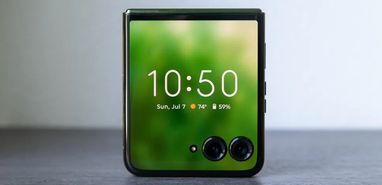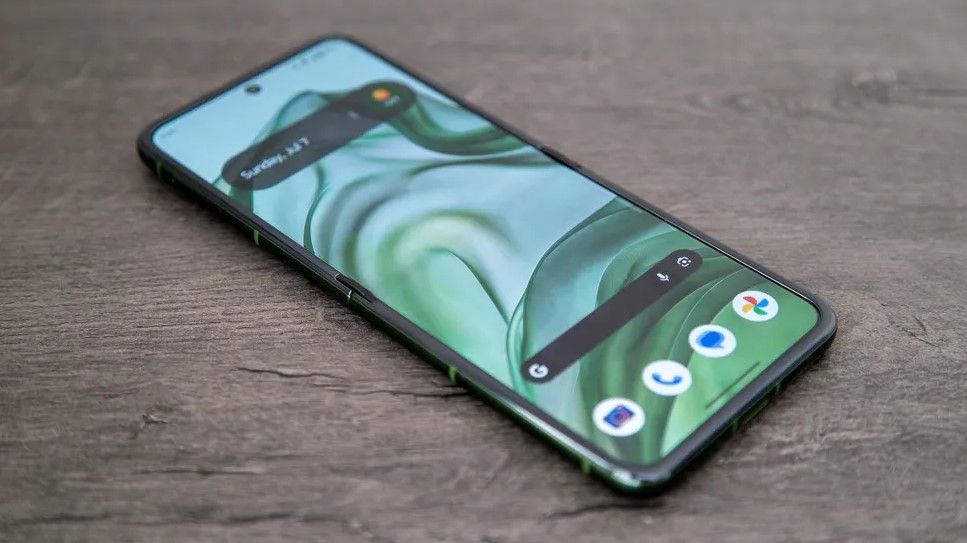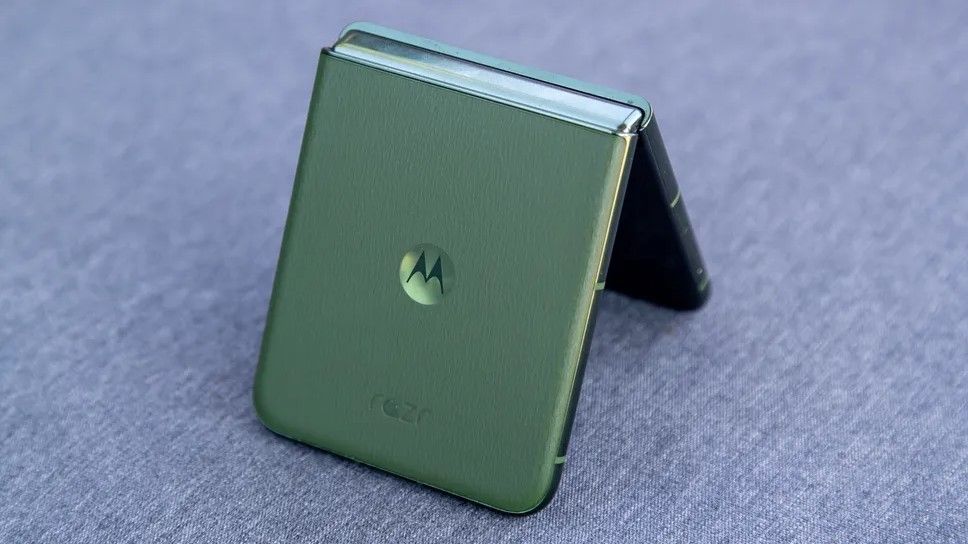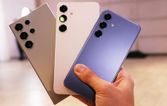
The larger, improved cover screen is a joy to use, but familiar issues remain.
It’s rare to feel delighted by a phone in 2024, but the Motorola Razr Plus manages to do just that. Sure, phones are amazing little computers. For $999, which is what the Razr Plus costs, they should be. But they’ve matured into tools rather than objects of joy, blending into the background of our lives. The Razr Plus stands out, not just because it folds in half.
One standout feature: one of the background options for the media controls on the cover screen is a turntable. When music is playing, the record spins with one of the camera cutouts at the center. Press pause and the needle lifts off the record and stops. It’s charming and delightful.

Motorola Razr Plus 2024: The Good and the Bad
The Good:
- IPX8 rating for full water resistance
- Bigger cover screen with a much-improved UI
- Good battery life
The Bad:
- Only four years of software support
- Vegan suede on the hot pink model is prone to scratches
- Inner screen is just average
There’s a lot to love about the Razr Plus, which makes the disappointments sting even more. The cover screen is incredibly useful—more so this year with helpful UI improvements. It now has an IPX8 rating, significantly upgrading its water resistance. Improvements to the hinge make the crease almost disappear when using the inner screen. These are significant upgrades. However, these improvements and delightful moments don’t entirely offset the Razr Plus’ long-term weaknesses.

The Modern Flip Phone Experience
If you’re new to modern flip phones, here’s a quick rundown: big phone inside, small phone outside. When flipped open, you have a regular smartphone with a big screen. When closed, the cover screen acts almost like a second phone, allowing you to check notifications and respond to texts without opening up your phone. Personally, I love them.
Motorola offers two versions of its modern flip phone: the Razr Plus and a more basic Razr. Both models have larger cover screens this year. The Razr Plus features a generous four-inch cover screen, up from last year’s 3.6-inch screen. It feels compact compared to modern phone displays. The bezel on top of the screen is much smaller, making last year’s model look like a prototype.
There are more ways to customize the cover screen this time around. You can place app shortcuts directly on the main page of the cover screen, and the calendar panel is much improved, surfacing more information with a few more viewing configurations. Even the flow for allowing apps to open on the cover screen is better. You can approve and open apps directly from the cover screen notification.
Overall, the cover screen experience is miles better than the previous generation. It feels mature and less like beta software. I’d choose this over the Samsung Galaxy Z Flip 5 any day. Motorola put a lot of thought into every aspect of the display, and it shows. The cover screen now supports Google Assistant (including Gemini) and an always-on display. It’s like all my dreams are coming true.

Inner Screen and Build Quality
The cover screen is delightful, but the inner screen is much more ordinary. It’s a 6.9-inch 1080p OLED. The resolution didn’t bother me much during testing, but the screen could benefit from a higher pixel count. It doesn’t get as bright as I’d like outdoors. It’s fine, but you can get a better display on a slab-style phone for the same money—or even less.
This year, Motorola adopted a new hinge design that minimizes the appearance of the crease when the phone is fully unfolded. The Razr Plus now has an upgraded IPX8 rating for water resistance, though it still lacks official dust resistance. This rating allows the Razr Plus to withstand full immersion in fresh water, a significant improvement over the previous generation’s “splashproof” rating. This puts it on par with the Galaxy Z Flip 5 (and likely the upcoming Z Flip 6).
The soft touch on the back panel is a nice touch, but the hot pink model I tested comes with a new “vegan suede” material. It feels papery and doesn’t seem to wear well over time. My review unit has a couple of faint scratches that don’t budge when I try to buff them out. Considering this isn’t just a case but the actual phone, that’s concerning. Other colors come with a vegan leather finish similar to last year’s pink model, which seems to have held up fine.
Performance and Software Support
The Razr Plus uses a Snapdragon 8S Gen 3 chipset, occupying an upper-mid-tier, low-flagship space in Qualcomm’s lineup. In the US, the Razr Plus comes with 12GB of RAM and 256GB of storage, which is plenty for daily use. An extended Pocket City 2 session didn’t strain it much, and battery life is commendable for a flip phone, thanks to the 4,000mAh cell that easily lasts through a day of heavy use.
However, Motorola’s software support remains a concern. The Razr Plus comes with three years of OS upgrades and four years of security updates. That’s adequate but pales compared to the seven years promised by Samsung and Google for their high-end phones. Even the $499 Pixel 8A offers seven years of support. I can’t help but expect more from a $999 phone. Motorola’s track record for timely updates isn’t great either; 2023 Razr Plus owners only just started receiving their Android 14 update, which doesn’t inspire confidence with Android 15 on the horizon.

Camera Performance
Camera performance has been a weak area for Motorola in recent years, and the Razr Plus hasn’t changed that. Motorola is trying to address the issue with a new feature called photo enhancement engine, which uses AI to improve noise reduction in low light, enhance bokeh in portrait mode photos, and boost dynamic range. However, the new photo processing pipeline hasn’t addressed core problems: portrait mode subjects are poorly isolated, background blur isn’t convincing, and color reproduction is uneven.
The system handles bright light well, producing great photos on a hike, but medium light remains challenging, resulting in flat, over-brightened images and oversaturated reds. The Razr Plus trades last year’s ultrawide lens for a 2x telephoto lens, offering nice zoom options for portraits. There’s also a 4x digital zoom, which is decent in good light. Without the ultrawide on the rear panel, you miss the chance for wide group selfies, but the main camera is wide enough for a couple of people.

Conclusion: Love It or Leave It?
Here’s the dilemma: I love using the Razr Plus, but it’s hard to recommend. The cover screen is a major part of the flip phone experience, and it’s much improved this year. It’s easier to use, more helpful, and highly customizable. For flip phone enthusiasts like me, it’s perfect.
But for those casually interested or drawn by nostalgia, better options exist. You can get a superior camera in a slab-style phone for much less, and a good camera matters for everyday use. Motorola’s history with timely updates remains patchy, and the inner screen isn’t up to modern flagship standards.
The standard 2024 Razr is worth considering if $999 is too steep. It offers a big cover screen and IPX8 rating at $699. While I haven’t tested it, it’s an enticing option. Meanwhile, the Galaxy Z Flip 6 is on the horizon. Motorola could learn from Samsung’s software approach with quick updates and long support periods. Samsung could also take cues from the Razr Plus—it’s a delightful phone.








By Andrej Kovacevic
Updated on 18th July 2024